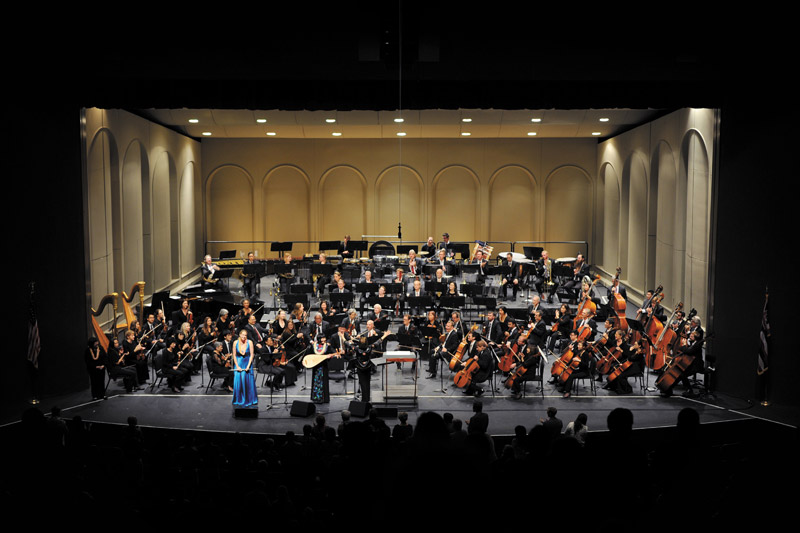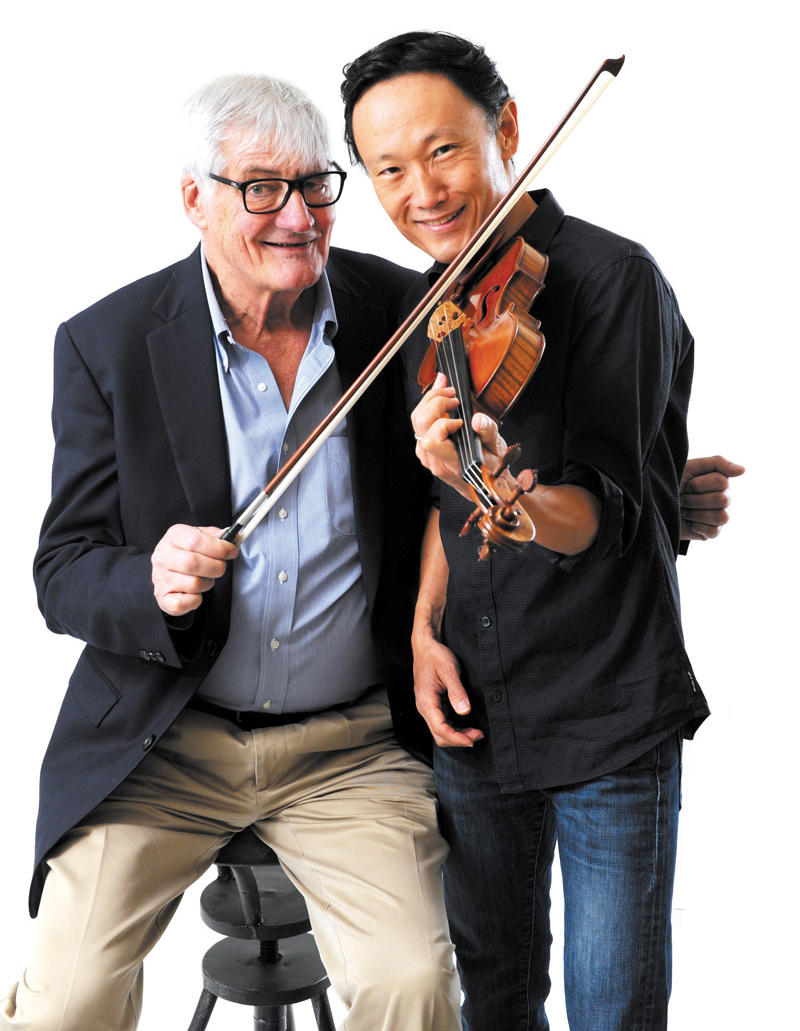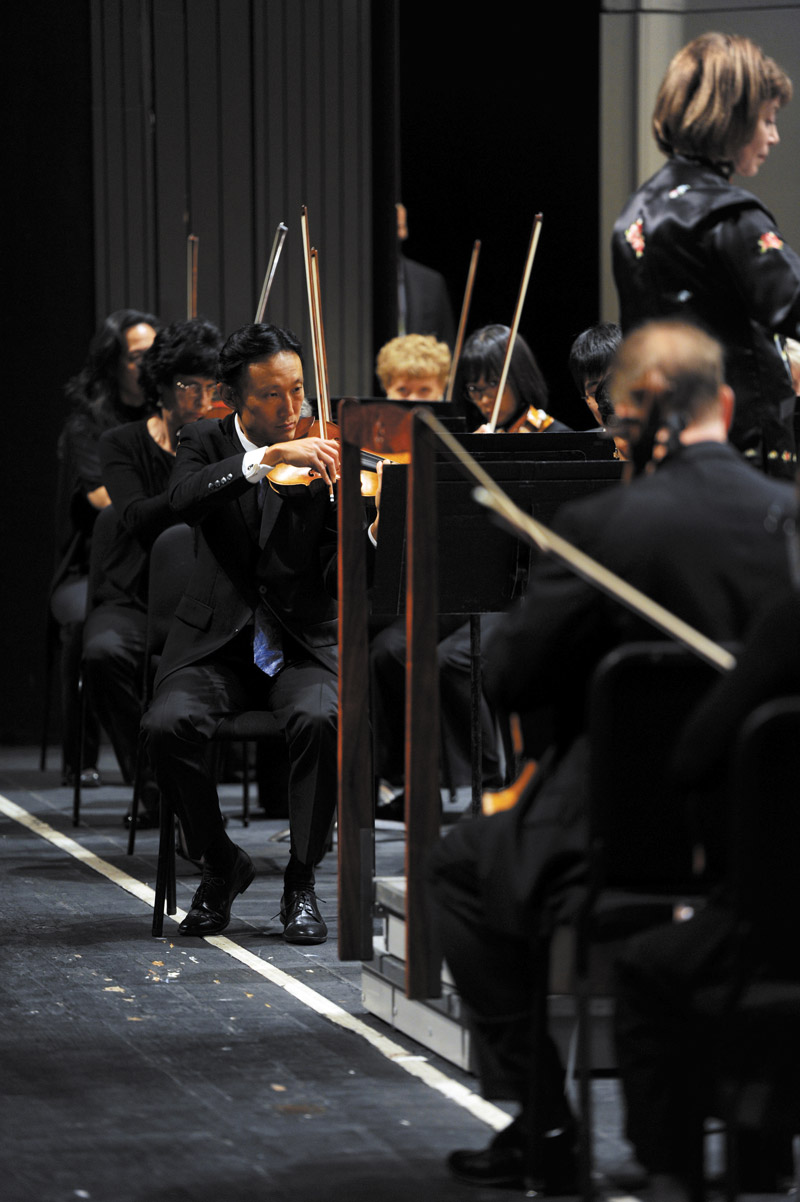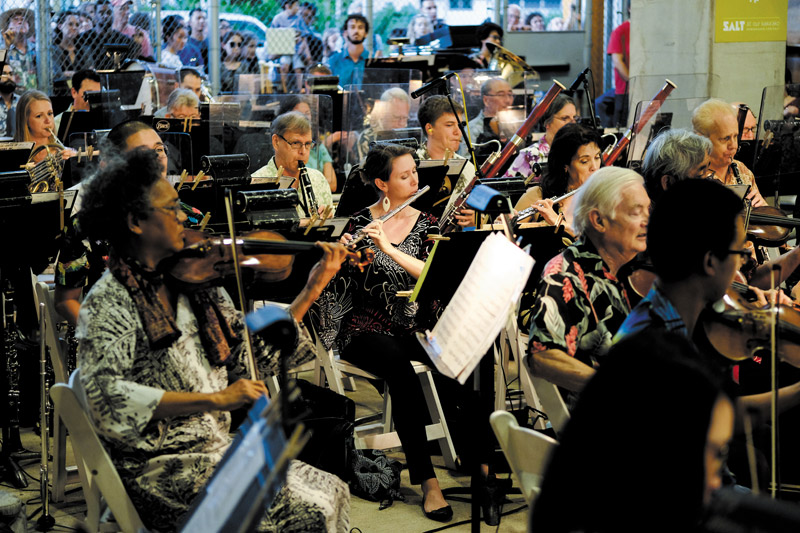‘Bach’ On Track

From classical faves to pop and rock hits, Hawai‘i Symphony Orchestra has a way of stringing together beautiful notes for all kinds of ears.
Applause echoed throughout the room as Hawai‘i Symphony Orchestra played the final notes of Bizet’s Carmen suite. Then, a familiar tune began to pick up. Faces broke out into smiles as recognition dawned. It was from Disney’s Pirates of the Caribbean: The Curse of the Black Pearl.
It certainly was a change in theme, though it probably didn’t come as much of a shock to those who know a thing or two about the orchestra. HSO has, after all, been known to expertly shift between the likes of Mahler, Tchaikovsky and Queen. But there was one difference about this performance. Rather than taking place at its usual venue at Blaisdell Concert Hall, this one was in The Barn at SALT at Our Kaka‘ako — the symphony orchestra’s first-ever free pop-up concert, which took place last month.
Peculiar? Maybe. But, boy, did it draw a crowd.
Attendees of all ages spilled out onto the sidewalk and into the courtyard. Some took to the second level in hopes of catching a glimpse of the orchestra.
At the front of the audience was a row of children eagerly looking on.

Michael Titterton, Hawai‘i Symphony Orchestra president, and concertmaster Ignace “Iggy” Jang
It was a scene of abject enchantment, and with Michael Titterton now on board as president, there hopefully will be more like it to come.
“This orchestra can be taken out of the concert hall and can do amazing things, and provide people with indelible memories and experiences.
“I’d love to do more — and the weirder the better,” he says.
A longtime fan of the nonprofit organization, Titterton, who admittedly knows nothing of playing an instrument or reading music — which, in his words, looks like “dead tadpoles” — has been president since May 2017. But what he lacks in musical background, Titterton makes up for with leadership.
He was general manager of Hawai‘i Public Radio for 17 years, retiring in 2016, before winding up at HSO a year later.
“I thought we’d get some traveling done and I’d catch up on reading, and I completely screwed it up,” he says.
Jokes aside, Titterton is committed to sustaining the orchestra, which currently is comprised of about 65 core musicians. Lest anyone forget, its predecessor Honolulu Symphony shut down in 2009. It wasn’t until three years later that the newly formed HSO played its first concert season.
Today, HSO has a rather robust schedule. In addition to Halekūlani Masterworks, which features classical arrangements, HSO also regularly puts on pops concerts and community shows.

Concertmaster Ignace “Iggy” Jang in action at a recent HSO show.
There are, however, a number of hurdles HSO faces in securing its future. Among them: budget struggles, cuts to music education in public schools, and the prevalence of smartphones and tablets.
Perhaps one of the biggest disparities Titter-ton has uncovered is the misconception many have of what they think an orchestra is.
“They think they know what it is and they’re completely wrong,” says Titter-ton. “They’re completely off base, and they’re losing so much as a result.”
Concertmaster Ignace “Iggy” Jang draws this comparison: You can be a fan of football, a very loud and rousing sport, and still appreciate golf, a much quieter affair.
Despite all this, Titterton is confident that Hawai‘i will rally to support its orchestra. It isn’t about proving its relevance, he insists; it’s about showing how useful HSO is.
“I believe strongly that an appreciation for good music is very important for mental health and, on top of all that, there’s the sheer pleasure,” says Titterton.
“I want other people to enjoy that and to share that, and I don’t want to live, frankly, in a community that can’t offer that anymore,” he adds. “I don’t want us to be the only state in the country that doesn’t have a symphony orchestra.”
Perhaps its biggest yet littlest known contribution to the community is that all HSO members devote time to educating the next generation. A majority, for example, work one-on-one with budding talent. Smaller ensembles, meanwhile, visit classrooms throughout the state.

Hawai‘i Symphony Orchestra performs at its first-ever pop-up concert at SALT at Our Kaka‘ako. ANTHONY CONSILLIO PHOTO
The goal is not to convince students that their future lies in music, but that music can teach them so much more. It empowers students with skills they can apply in every aspect of life — discipline, an appreciation for a craft and aiming for excellence, to name a few.
An orchestra is “useful” in many intangible ways, too. It can be an almost spiritual experience for listeners and players alike. It’s what inspired Jim Moffitt, an associate principal clarinet who got his start with Honolulu Symphony in 1981, to play in the first place.
“I found a deeper emotional attachment than I did to other forms of music,” he says. “I find it extremely compelling, and I think people still find that.”
Classical music also can be considered a more dynamic way to communicate.
“You can feel emotions without having to find words for it,” says Jang.
In fact, music plays an important role in virtually every facet of life, as Claire Sakai Hazzard, associate concertmaster and a violinist who has played with the symphony for more than 42 years, notes. In Hawai‘i, especially, music is ingrained in our culture.
“Even in silent movies, there might not have been a dialogue but there was music, which reinforced what was happening visually on the screen,” she adds. “If you were to watch any movie without a soundtrack, it would be … absurd.”
Of course, this isn’t to say that listening to other genres of music is any less of a thrilling experience. Titterton, who hails from the East End of London, drives around with Pink Floyd and Eric Clapton CDs in his glove box, while Jang is a fan of Motown.
But there’s something indescribable about classical music that sets it apart from the rest.
“There are emotions that I can absorb and recognize and appreciate and enjoy that come from classical music that can’t come from anything else, and I don’t find those two things to be contradictory at all,” says Titterton.
It’s a message and passion that Titterton hopes more of Hawai‘i shares as he and HSO forge ahead.
Some of this will entail attracting younger audiences. In some cases, this might mean reaching out to children as its members currently do. In fact, Titterton is hoping that support from the community will allow HSO to offer special discounts to teachers.
Then there are those younger audiences who might not yet have developed an appreciation for the art form. Perhaps they think of the orchestra as stuffy. That, says Titterton, will come down to simply demonstrating that “a symphony orchestra — any symphony orchestra, but especially ours — provides a vibrant and enriching experience.”
“Classical music is sort of the foundation of everything that we know is music,” adds Rachel Saul Schifino, a 29-year-old violinist with HSO. “I think a lot of young people don’t realize how much they actually know about classical music.”
In expanding its reach, Titterton teases potential changes to Halekūlani Masterworks that will shift the concert experience. HSO also will continue to offer musicthat-POPS, sponsored by Sheraton Waikīkī, which celebrates current trends in music. Later this year, HSO has a couple of musicthatROCKS shows, too, that will showcase hits from Prince and Led Zeppelin.
“These concerts are about as far from the traditional — and mistaken — idea of a staid and sober classical concert as it’s possible to get,” says Titter-ton. “Dancing in the aisles is encouraged.”
HSO is looking at other ways to grow, too. The group soon will bring its talents to Waikīkī, for example, for free shows.
All of this, meanwhile, will take place during what may be the biggest task ahead for HSO: a temporary change in venue as long-awaited renovations to Blaisdell Center loom. There’s no official word yet on when exactly those will start, though Titterton expects it will be soon. But with the orchestra sounding top-notch these days, Titterton isn’t too concerned.
He’s got all sorts of ideas.
“I’m very excited about it,” he says. “It’s a tremendous opportunity to redefine ourselves.”
For tickets to upcoming shows and more information, visit hawaiisymphonyorchestra.org.
MEET IGGY
A concertmaster, explains Ignace “Iggy” Jang, is sort of like a team captain. At least, that’s the metaphor he uses. The title has roots that extend back a few hundred years, when musicians played in smaller groups without a conductor. In these instances, there was either a pianist or first-chair violin leading the ensemble.
The position evolved throughout the years as groups and venues began to grow. Today, a concertmaster, while still the first-chair violin, deals with “intangibles,” as Jang puts it. He might, for example, convey the thoughts of a conductor to the other musicians in way that is easier to understand.
Jang has served as concertmaster of Hawai‘i Symphony Orchestra, and its predecessor Honolulu Symphony, since 1997. Born and raised in France, he has lived and worked in a variety of locales. In fact, after Honolulu Symphony went bankrupt and before HSO was established, Jang spent a lot of time in Europe, where he received an offer to move to London.
Ultimately, of course, he chose to stay here.
“You don’t have the same cultural tradition as you may have in Paris and London, but there’s some sort of thirst for knowledge — a purity, an openness that I enjoy,” he says.
“I felt like I wanted to reach out to our future,” he adds. “You see the young violinists or pianists and you feel like you want to climb the highest mountains for them.
“Or, I guess, dive into the deepest oceans,” he amends with a laugh.





